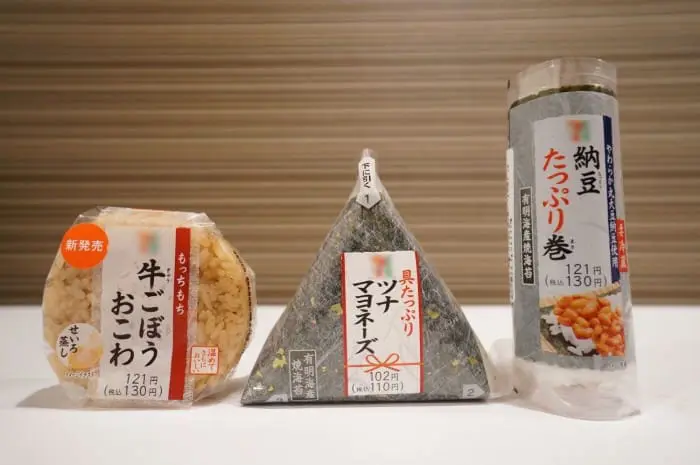Onigiri And Omusubi (Rice Balls) - Japanese Encyclopedia

Simple, cheap, portable, and delicious, onigiri and omusubi, or rice balls, have been loved by the Japanese since ancient times. We introduce what rice balls consist of, how to make them yourself, and where you can enjoy some of the best onigiri in Tokyo.
Onigiri - Japanese Rice Balls

Onigiri and omusubi are rice balls formed into triangles or cylinders, a very common snack in Japan.
Onigiri and omusubi have a long history. Hard clumps of steamed rice, thought to be primitive versions of onigiri, have been discovered at ruins dated from the first century A.D. Since then, rice balls have been used as rations for soldiers and portable meals for travelers. They are still indispensable to the Japanese dining table as meals for people on the go, as light snacks, or as a picnic dish.
Learn more about what onigiri and omusubi are, how to eat them, common ingredients, and how to make them yourself to enjoy this very important aspect of Japanese food culture.
What are Onigiri and Omusubi? Differences and Origins

Photo by Pixta
Onigiri and omusubi are made by cooking rice, molding it into a triangle or other shape by hand, then inserting other ingredients into the rice. They are called either onigiri or omusubi depending on the region, store or household, but neither is the “correct” way. There is no particular difference between the two, but there are various explanations as to why people call them “onigiri” or “omusubi.”
We’ll introduce a few of these explanations here. The first theory claims that omusubi are named after Takamimusubi and Kamimusubi, two of the creation gods from Japanese mythology. Japanese people of old, who deified mountains as gods, would share in that divine power by molding their rice into mountain shapes; these were then called “omusubi.”
Another theory states that during the Heian period, people of high social status referred to their rice balls as “omusubi,” while commoners called them “onigiri.” Other theories claim that the words onigiri and omusubi are derived from “oni o kiru” (meaning “to cut down evil spirits”) and “en o musubu” (meaning “to forge a relationship”). There are various other explanations as well.
How to Make an Onigiri Rice Ball

Photo by Pixta
The basics of how to make onigiri or omusubi are simple. Take freshly-cooked rice, and mold it with both hands into your desired shape while it is still warm; then all you have to do is insert a filling. Wet your hands slightly and sprinkle your palms with a little salt each time you mold an onigiri. People mold onigiri into triangles, balls or barrel shapes.
These days, there are even onigiri shaped like stars or hearts. In recent years, a new style has become popular, known as ‘onigirazu,’ which can be completed by just wrapping the rice and its filling in nori seaweed, without molding it.
An Endless Number of Onigiri Types

Photo by Pixta
Onigiri and omusubi have many flavor variations depending on the combination of ingredients. Let’s take a look at the ingredients that make up the inside and outside of an onigiri.
The exterior is typically wrapped in nori seaweed, but you can also see onigiri wrapped in thin omelets, coated with furikake (Japanese seasoning powder), or dressed with grated yam and sesame seeds.
There are also fillings that have been staples since ancient times, such as pickled plums, dried bonito flakes, and kombu seaweed. Other fillings that have been popularized in the last decade include tarako fish roe, mentaiko fish roe, tuna with mayonnaise, and shrimp with mayonnaise.
In addition, there is no end to the new onigiri variations that people continue to devise, such as ‘ten-musu onigiri’ (topped with shrimp tempura) and ‘niku-maki onigiri’ (wrapped in meat).
Onigiri Recommendations

Picture from How to Open a Convenience Store Rice Ball
Onigiri and omusubi will slightly vary in price depending on the store and the ingredients, but you can expect to pay 100 to 200 yen for one. They are sold at places like convenience stores, kiosks, bento box shops, and izakayas all over the country.
There are also shops that specialize in onigiri and omusubi such as Gonbei (Japanese), which has branches all over the Tokyo metropolitan area. At Tokyo’s oldest specialty onigiri shop, Onigiri Asakusa Yadoroku, you can see the staff making the onigiri in front of your eyes.
Practically every person in Japan has enjoyed the taste of handmade onigiri and omusubi from their earliest childhood. How about trying one for yourself?
This is the official account of MATCHA's editorial department. Our articles feature useful travel information for visitors to Japan, from how-to guides to recommended places to visit.





































![[2026] Top 5 Strawberry Picking Spots in Tokushima, Naruto| Farms and Access Guide for January to May](https://resources.matcha-jp.com/resize/720x2000/2025/03/06-227165.webp)
![[Yamanashi/ Hokuto City] 4 Hot New Spots Opening in 2026](https://resources.matcha-jp.com/resize/720x2000/2025/12/12-252747.webp)


